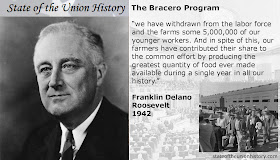There was once a time, when the United States collectively praised the "great enthusiasm" of Mexican workers crossing the border. These manual laborers or "braceros", according to President Roosevelt were providing an "important role that our Mexican allies can and are taking in the war of production, upon which the inevitable success of our military program depends". But, just 9 years later, the enthusiasm of these workers led to illegal braceros in the words of President Truman having a "seriously depressing effect on wages and working conditions in farm areas throughout the southwest". What once was the help of a welcome ally in World War II, soon became a painful division between two neighboring countries.
On June 2nd, President Roosevelt sent his "warm personal regards" to His Excellency General Manuel Avila Camacho of Mexico for joining the Untied States and declaring war on Germany, Italy and Japan. While only the Mexican Air Force saw any combat, there were many Mexicans who joined the US Armed forces and fought valiantly in Europe. Yet, Mexico helped the war effort in a much different way, often overlooked by history books. On August 4, 1942 arrangements were made under an agreement with the Mexican Government to bring in agricultural workers to replace the millions of young men who left the US labor force. This arrangement later became known as the "bracero program". The term "bracero" means "manual worker" in Spanish. On October 20, President Roosevelt held a press conference where he answered several questions on bracero program. According to Roosevelt, there were in 1942 3,000 Mexican agricultural workers in the program, mostly in California. Mexican Workers were crossing the boarder "with great enthusiasm, and have marked their trains with banners expressing their eagerness to serve the democratic cause by saving harvests vital to the war effort of the United Nations." According to Roosevelt, there were thousands of other Mexican farm workers already registered with their government, willing and ready to help in the harvest fields of California. Roosevelt called it an "important role that our Mexican allies can and are taking in the war of production, upon which the inevitable success of our military program depends."
In the 1942 State of the Union Address by Franklin Delano Roosevelt, I found no reference to the Mexican workers, but I did find a statement to the millions of young workers that went off to war. According to the president , these Workers left a labor shortage in the farms of America, but despite this our farmers had contributed to the war effort by "producing the greatest quantity of food ever made available during a single year in all our history". There is no doubt that the bracero program contributed to this success.
"While we have been achieving this miracle of production, during the past year our armed forces have grown from a little over 2,000,000 to 7,000,000. In other words, we have withdrawn from the labor force and the farms some 5,000,000 of our younger workers. And in spite of this, our farmers have contributed their share to the common effort by producing the greatest quantity of food ever made available during a single year in all our history."Included in the bracero program was an agreement between the United States and Mexico that the U.S. would provide decent living conditions and a minimum wage of 30 cents an hour. During the war years, only a relatively small number of braceros were admitted into the program and never accounted for more than 10 percent of U.S. hired farm laborers. The workers were allowed into the country on a contact basis to assist in harvesting vital crops, especially cotton, sugar beets, citrus fruits and vegetables. They were primarily used int the southwestern states. Despite this small start, U.S. employers became heavily dependent on braceros, and by 1950 there were 70,000 braceros legally admitted into the U.S. for the harvest season. Ah, but this was just the tip of the problem. In that same year, there were 500,000 illegal immigrants apprehended and returned to Mexico. That "eagerness", Roosevelt spoke of in 1942 had grown exponentially. U.S. employers had not just grown dependent on the legal braceros, but also on what President Truman referred to as the "wetbacks" who crossed the Rio Grande illegally for their share of the manual labor. By 1951, President Truman was calling for reform. Aside from the exploitation of the illegal immigrants who were often left in abject poverty, the presence of these illegal braceros had a "seriously depressing effect on wages and working conditions in farm areas throughout the southwest".
note: I will cover more on the bracero program at a later date, when I cover Truman actions to enact the bracero program into Public Law 78 in 1951. After signing Public Law 78, the bracero program stayed in effect until December 1, 1964
http://www.presidency.ucsb.edu/ws/index.php?pid=16386
http://www.presidency.ucsb.edu/ws/index.php?pid=16263
https://www.thoughtco.com/mexican-involvement-in-world-war-two-2136644
http://www.presidency.ucsb.edu/ws/index.php?pid=16180
http://www.presidency.ucsb.edu/ws/index.php?pid=13837
http://www.unco.edu/cohmlp/pdfs/bracero_program_powerpoint.pdf
https://upload.wikimedia.org/wikipedia/commons/b/ba/BraceroProgram.jpg

No comments:
Post a Comment